
Image by Praisaeng at FreeDigitalPhotos.net
While plenty of industries abhor corrosion and its consequences, another sector has welcomed it as a step in the healing process: medical devices. Devices have evolved over the decades to be less-intrusive during (and after) implantation.The bio-inert nature of titanium (along with its weight and strength characteristics) has made it the go-to material for structural orthopedic implants (hip and knee joints, bone plates and screws, etc.). These implants are made to go into the patient’s body and remain there, hopefully performing well for an extended period of time without the need for replacement. But what about implantable devices that have a finite life of medical functionality, and afterwards can become detrimental to the patient’s quality of life?
Such is the case with attaching soft tissues to bone during ACL repairs, as described in a recent issue of Advanced Materials & Processes. Stainless steel or plastic attachments have been the accepted materials in the past because of their strength and biocompatibility behaviors. However, once these devices have done their job they can be hard to remove, or can (in the case of stainless steel) cause metal sensitivity in the patient. Implanted screws made of polymer-based biocomposites have been shown to degrade at a safe rate in living bone and tissue. This allows the repaired ligament to heal, while the tool itself is slowly absorbed by the body using its own metabolic conversion system (the Krebs cycle).
Another example is the performing of a balloon angioplasty to unblock clotted arteries. The device employed in this procedure is a balloon-tipped catheter, which widens the artery. A metallic mesh stent is placed in the area where the work was performed, to keep the artery open as it heals from the procedure. The mesh stent never goes away, which can have an unintended outcome as time progresses. In an ideal world, the stent would remain properly positioned in the artery and cause no further damage. In reality, the stent has the opportunity to create major issues in the body after the artery’s healing time (localized inflammation, or structural breakdown resulting in stent fracture and arterial wall damage). A research group at Michigan Tech is looking to take the bio-corrodible nature of zinc and use it to their advantage in stent design. An alloyed zinc stent would perform the necessary function of propping the blood vessel open as it heals, and then would break down into products that are harmless to the body after its function is complete. The degradation rate for zinc in the body has been shown to be approximately 0.015 millimeters/month for the first three months (the crucial timeframe for stent functionality), with an accelerated rate after that.
VEXTEC’s past success with modeling corrosion-induced damage propagation (previously used for corrosion mitigation purposes) provides an exciting opportunity to repurpose this methodology to model the corrosion state in materials and devices in which degradation is in fact encouraged. Whether seen as detrimental or beneficial, the processes of corrosion and fatigue are interrelated. The key to merging the two phenomena lies in reducing the size of the initial flaw (as described by traditional damage tolerance analysis) to better reflect the size ranges that are observed in corroded surfaces. In the realm of bioabsorbable medical devices, the ongoing degradation due to corrosion can be explicitly accounted-for during the service life of the implanted devices. The randomized load patterns of a given virtual patient (or a population of patients) can provide the external loads necessary to perform simulated damage progression. This analysis could provide insights into the reliability of a temporary implant and its effect on a patient’s wellbeing.




Leave A Comment